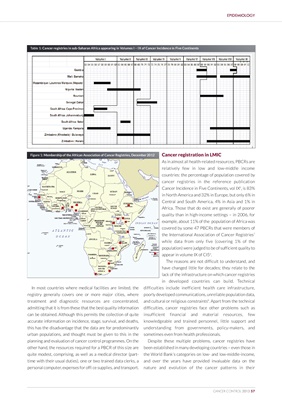
EPIDEMIOLOGY
Table 1: Cancer registries in sub-Saharan Africa appearing in Volumes I – IX of Cancer Incidence in Five Continents
!
Figure 1: Membership of the African Association of Cancer Registries, December 2012 Cancer registration in LMIC
As in almost all health-related resources, PBCRs are
relatively few in low and low-middle income
countries: the percentage of population covered by
cancer registries in the reference publication
Cancer Incidence in Five Continents, vol IX6, is 83%
in North America and 32% in Europe, but only 6% in
Central and South America, 4% in Asia and 1% in
Africa. Those that do exist are generally of poorer
quality than in high-income settings – in 2006, for
example, about 11% of the population of Africa was
covered by some 47 PBCRs that were members of
the International Association of Cancer Registries7
while data from only five (covering 1% of the
population) were judged to be of sufficient quality to
appear in volume IX of CI56.
The reasons are not difficult to understand, and
have changed little for decades; they relate to the
lack of the infrastructure on which cancer registries
in developed countries can build. Technical
In most countries where medical facilities are limited, the difficulties include inefficient health care infrastructure,
registry generally covers one or more major cities, where poorly developed communications, unreliable population data,
treatment and diagnostic resources are concentrated, and cultural or religious constraints8. Apart from the technical
admitting that it is from these that the best quality information difficulties, cancer registries face other problems such as
can be obtained. Although this permits the collection of quite insufficient financial and material resources, few
accurate information on incidence, stage, survival, and deaths, knowledgeable and trained personnel, little support and
this has the disadvantage that the data are for predominantly understanding from governments, policy-makers, and
urban populations, and thought must be given to this in the sometimes even from health professionals.
planning and evaluation of cancer control programmes. On the Despite these multiple problems, cancer registries have
other hand, the resources required for a PBCR of this size are been established in many developing countries – even those in
quite modest, comprising, as well as a medical director (part- the World Bank’s categories on low- and low-middle-income,
time with their usual duties), one or two trained data clerks, a and over the years have provided invaluable data on the
personal computer, expenses for offi ce supplies, and transport. nature and evolution of the cancer patterns in their
CANCER CONTROL 2013 57